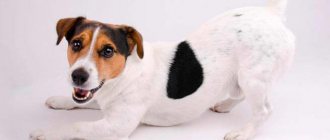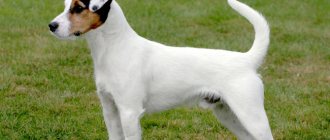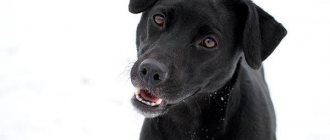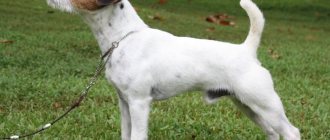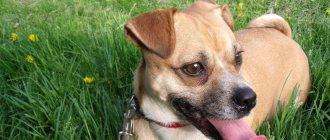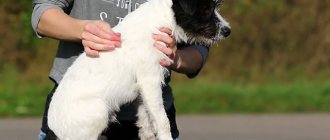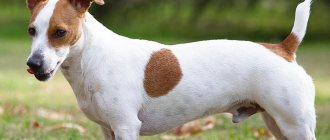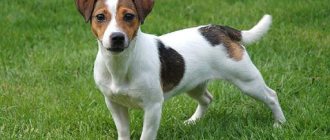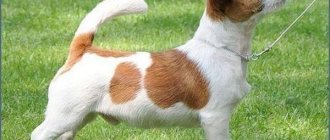Why does a dog need clothes and shoes?
Why dress a dog? In my opinion, it is necessary to dress your pet. After all, our domesticated animals are no longer the same descendants of wolves. Most domestic four-legged animals spend most of their time at home, warm and dry. And they no longer have that strong immunity like their ancestors - wolves, who were forced, despite all weather conditions, to spend their whole lives outside. And in the conditions of “urban civilization,” clothing has become a banal necessity.
In some cities in winter, to prevent icy conditions, it is customary to sprinkle the streets not with sand, but with salt. After two years of wear on such “salty” roads, winter boots turn into holey “galoshes”, and cars after several years of operation become rusty “troughs”.
What can we say about the tender paws of our smaller brothers? Salt corrodes them to the point of bleeding wounds, and cracks form on the pads. It's good if you have a small dog like our Jack. When we go for a walk in our favorite meadow in winter, I always carry Jack in my arms across the road, sprinkled with salt. What if you have a large dog that you simply physically cannot lift?
This is why protective equipment such as boots were invented. In the summer, dog shoes protect delicate paw pads from burns on hot asphalt, sharp gravel and cuts from broken bottles.
By dressing your dog, you, first of all, protect it not only from the “creations” of human hands, but also from adverse environmental factors: low temperature, wind or precipitation.
Why dress a dog? Yes, here's why:
- In recent years, many exotic dog breeds have appeared that are not adapted to the harsh climate. Such animals freeze and catch a cold at the slightest draft or drop in temperature.
- In addition, some four-legged animals are cut and trimmed, which disrupts the temperature imbalance in the body.
- Clothes for dogs protect the animal’s body from dampness, dirt and deicing agents.
- It is also additional protection from wind and frost for short-haired animals that do not have undercoat. These are such breeds as: smooth-haired Jack Russell terrier, boxer, pinscher and others.
- Clothing protects long-haired pets from dirt in rainy and slushy weather, thereby making it easier for owners to care for their fur.
- Clothing protects hunting breeds from burrs, thorns, insects and various wounds and scratches.
- Finally, it is simply necessary to dress older dogs, since due to age, the natural thermoregulation of their body malfunctions with age.
Continuing the topic, let's talk about how to choose the right clothes for your pet and what models of dog wardrobe are produced by the modern industry. By the way, look at the hat I recently knitted for a dog!
What is it for?
To prevent your pet from becoming hypothermic in the cold season and eventually getting a cold, he needs to be dressed warmly.
Many people believe that if properly maintained, the dog is adapted to moisture, low temperatures and snow.
They prove the harm of clothing for dogs rather than its benefit.
The pet may feel uncomfortable, in addition, a greenhouse effect occurs and at the slightest draft it can catch a cold.
The Jack Russell Terrier is an active dog with a short coat. You should walk with him in any weather, so it is important to take care of his health.
The most basic types of clothing for Jack Russell Terriers are capes and blankets.
A cape is a fairly short round cape with a clasp at the neck, possibly with a hood.
It perfectly protects from rain, as it is made of water-repellent materials (mainly bologna).
A blanket is a kind of blanket or blanket for a pet.
The density of the fabric depends on the time of year. Sewing it at home is quite simple. This is a rectangular piece of fabric thrown over the dog’s back and secured with ribbons or other fasteners.
This type of clothing may be useful after swimming or during cooler times of the day. It will not be difficult for an experienced needlewoman to knit a sweater or cardigan for her beloved pet.
How to choose the right clothes for your dog
There are many varieties of dog clothing: autumn and winter overalls (with “sleeves” and “pants”), vests, blankets, knitted sweaters and denim jackets, elegant skirts and suits, and much, much more.
Stores offer clothes for pets for every taste and color.
In recent years, people have experienced a boom in doggy glamour. They spare no expense to make their pet look cute and funny, according to the latest dog fashion. But does the animal need all this? Of course not.
How many times have I observed such a picture when a dog “packed” in dog clothing brands simply stood up in a stupor and refused to walk because it was uncomfortable for him. What can I say, and our Jack is not too happy when I put a completely closed jumpsuit on him. It's like he's being replaced. His movements become chaotic, he constantly shakes himself off, trying to throw off his overalls, and his gait becomes very funny (on four legs fully straightened, like on stilts).
To prevent your pet from feeling discomfort when moving, it is important to choose the right clothes for him.
What you need to pay attention to when choosing clothes for your pet:
- First of all, clothes should not restrict movement, not put pressure on the paws, neck, but at the same time not “dangle”.
- Choose items that are easy to put on and take off.
- Choose clothes taking into account the anatomical features of your pet. The overalls should not interfere with the fulfillment of natural needs.
- Don't skimp when choosing a jumpsuit for your pet. As a rule, in the manufacture of more expensive models, various “membrane” fabrics are used, which are used in sewing clothes for athletes, fishermen and hunters. Such materials “breathe” and the animal under them does not overheat or get wet.
- Autumn overalls should be made of waterproof material and have a thin, light lining. Winter clothing, as a rule, is made from a synthetic waterproof top and an insulated padding polyester lining. Such clothes are easy to wash, dry quickly, do not fade and weigh little.
- Very often you can find sewn reflective stripes on overalls. This is also important in the dark to control the movements of your tail, or to indicate the presence of a dog next to you when crossing the road.
- Recently, knitted clothing has become popular among dog breeders. Such things look elegant, but there is very little practicality in them. They do not hold their shape well, quickly “stretch out”, get dirty and wet. It is good to walk the dog in such knitted sweaters except in frosty and dry weather, when there is no rain or snow outside.
- And finally, if you are going to buy clothes for your four-legged friend, it is best to take him with you to the store so that you can try the item on right away.
By the way, you can also read how to choose a New Year's costume for a dog and how to make it yourself.
When is it necessary to dress a dog, and in what cases does the animal not need clothing?
If you are the owner of a dog with short hair, then in most cases, your pet will not need clothing. It is necessary to dress a short-haired animal only if it is very dirty or cold outside.
We usually dress Jack only in heavy mud in late autumn or winter, when the air temperature drops from -15 (and even with the wind). And even then, in the cold we try not to wrap him up at all. Until minus 20-22, Dzhekusik walks around in this vest, which, by the way, we came across very fortunately.
This is the only thing from his numerous wardrobe in which he feels absolutely comfortable. Even in heavy rain, Jack happily runs around “naked” with us.
Whether your dog likes to walk in the rain or not depends entirely on the owner. A dog should not like or dislike rain. She should treat any weather calmly.
You shouldn’t wrap your short-haired animal in a rain suit at the first drops of rain. This can lead to disruption of thermoregulation and deterioration of the coat.
Owners of long-haired dog breeds, on the contrary, should protect the animal’s fur from dampness, since constant washing and drying of fur after going outside is very harmful to both the fur and the health of the pet.
In winter, larger dogs with thick, dense hair do not need clothing. They will be very uncomfortable if you put a jumpsuit or vest on them. They can simply overheat. The fur of such animals is already genetically designed to protect them from cold temperatures. These breeds include Laikas, Malamutes, and St. Bernards.
But the dogs that need to be protected in the cold are Chihuahuas, various terriers and pinschers.
I hope today we answered the question of why to dress a dog. Of course, all dogs have a natural internal thermoregulation system. However, some of them lack thick fur and are not genetically adapted to withstand severe frosts and temperature fluctuations.
Setting rules
- home
- Setting rules
Before you welcome little Jack into your home, agree with all family members on general rules that everyone will strictly follow.
Immediately agree whether you will allow your Jack to sleep in a chair, sit on the sofa, or sleep in the master’s bed. We are not saying whether this is good or bad. Just solve this issue as a family. It is completely unacceptable for the mother to allow the puppy to sleep in the bed, and the father to drive him out of there. The puppy will simply fall into bewilderment: he is being scolded for something that was previously allowed. It is important that in certain situations your behavior is always the same. Jack should not be allowed to do something occasionally, as an exception, in honor of a holiday, something that is not usually allowed. This will help establish your dominance over Jack from day one. You are the boss, you make the rules. It doesn’t matter whether you allow Jack to sleep on the sofa, in fact, there is nothing wrong with that, it’s your own business. But when it comes to handouts from the table, set a clear rule: NEVER! When the family is eating, the puppy should not be hovering under the table and begging. He is such a charmer, he looks with such pleading hungry eyes, how can you not give him a tasty piece? It can be funny and touching while Jack is little. But when he grows up, you will get an annoying beggar, hovering under your feet during lunch and barking for a treat. Besides the fact that the food from our table is not only not healthy, but also harmful for Jack, it is very difficult to wean him from this bad habit (although, of course, any behavior can be corrected), because it has been fixed since childhood.
Determine where the puppy will sleep. It should not be in the aisle, near heating radiators, or in a draft. The place should be away from doors, so that when you leave, Jack does not see the door through which you left and does not try to follow you out. In general, give the pet the right to choose. He will go to bed where he is comfortable. Watch him and place his house or sofa in the place that he chooses to sleep.
Always remember an important rule: “You are the leader of the pack and all the initiative comes from you. The dog obeys your wishes, but not vice versa. The dog is for you, but not you for the dog.”
The location of the “dog dining room” is also important.
Once defined, it should not change. Agree on the commands you will use in different situations. Choose a single prohibitive word: “Fu,” “You can’t,” “No.” Determine who will clean up after the puppy and walk with him. If you have children, actively involve them in caring for the puppy. This instills in children a sense of responsibility and instills a love for little Jack.
Set behavioral boundaries for your puppy. Jack always uses his teeth when playing. He does not distinguish between your hands, designer walls and expensive furniture. You are the very person who must explain to him what he can pick up and chew and what he cannot. Don't let Jack play with his teeth with your hands. Subsequently, when his teeth are replaced by permanent ones, this may turn out to be painful and unpleasant. If your puppy grabs your hands with his teeth, firmly tell him “No” and offer him a toy in return. When your puppy takes the toy, praise him. Be persistent and he will soon understand acceptable limits.
It is important for Jack to learn what he can do and what he cannot do, and he must also know who is in charge in the house. This will make his life and yours happier and calmer. If you do not explain to him the “rules” of behavior in your pack, this can lead to behavior problems in the future.
Always remember: stability and consistency in training helps your puppy gain confidence and calm.
When you first brought your Russell puppy home, he jumped into your arms, licked your face and nibbled your wrists - you thought it was very cute. They caressed, kissed and stroked him back. You may have even encouraged him, but a year has passed and Jack is still jumping, licking and petting, but you don't think it's so cute anymore. Behavior that was previously rewarded with caresses and stroking suddenly changed to anger, pushing away and dissatisfied looks. What should the dog think?
Video: Do you need to dress your dog?
In this video we will tell you why you need to dress your dog. What adverse factors can clothing protect your pet from? We will also show you the entire wardrobe of our Jack Russell terrier Jackusik.
Do you dress your dogs? If yes, at what temperature? Share your observations and personal experiences in the comments.
Each dog owner must determine for himself whether the four-legged dog is comfortable or not, and take all necessary measures to preserve and maintain the health of his tailed pet.
Good luck to you! Take care of your pets!
How to choose a Jack Russell Terrier puppy?
In order to buy not only a beautiful, but also a healthy baby, you need to know what to look for. Professionals recommend visiting several specialized nurseries and choosing the best pet. To prevent Jack Russell Terrier puppies from turning into mongrels, it is not recommended to purchase them in dubious stores or on the market. Dogs without a pedigree may have hidden defects that become apparent later, so it is important to examine the litter and find out reviews about the breeders and their dogs.
When studying the Jack Russell Terrier breed, we note that the price of animals can fluctuate greatly because it depends on many factors. Average cost $500-700. Puppies should be active and look good. The place of detention must meet the requirements:
- Puppies should be kept warm and clean.
- The floor should not be slippery to prevent children from injuring their feet.
- There must be a separate place for sleeping in the enclosure.
- Spring litter should have room to play outside.
